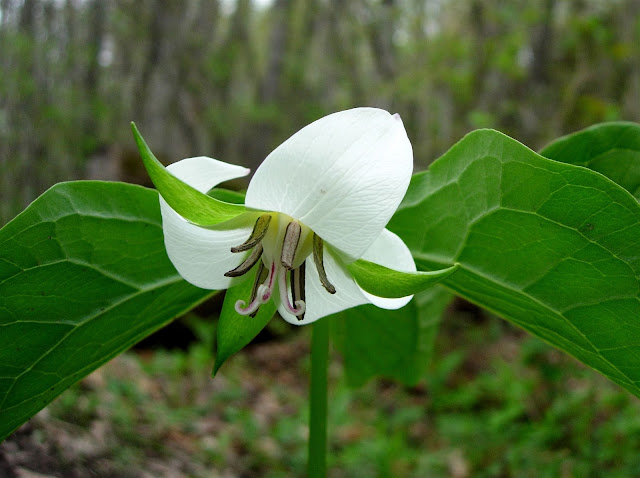During my hikes in the North Woods a couple weeks ago, I wondered how trillium were pollinated, speculating that the role was probably filled by solitary bees rather than wind. I've subsequently found this:
Trillium grandiflorum has been studied extensively by ecologists due to a number of unique features it possesses. It is a representative example of a plant whose seeds are spread through myrmecochory, or ant-mediated dispersal, which is effective in increasing the plant's ability to outcross, but ineffective in bringing the plant very far...That discussion relates more to seed dispersal than to pollination per se, but I thought it was interesting (and totally new to me).
Fruits are released in the summer, containing about 16 seeds on average. These seeds are most typically dispersed by ants, which is called myrmecochory, but yellow jackets (Vespula vulgaris) and harvestmen (order Opiliones) have both been observed dispersing the seeds at lower frequencies. Insect dispersal is aided by the presence of a conspicuous elaiosome, an oil-rich body attached to the seed, which is high in both lipids and oleic acid. The oleic acid induces corpse-carrying behavior in ants, causing them to bring the seeds to their nesting sites as if they were food. As ants visit several colonies of the plant, they bring genetically variable seeds back to a single location, which after germination results in a new population with relatively high genetic diversity...
Although myrmecochory is by far the most common dispersal method, white-tailed deer have also been shown to disperse the seeds on rare occasions by ingestion and defecation. While ants only move seeds up to about 10 meters, deer have been observed to transport the seeds over 1 kilometer... Thus occasional long distance dispersal events, such as by deer, probably helped save this and other species with otherwise short distance dispersal ability from extinction during the glaciations of the ice ages.
Bent Trillium photographed by me at Honey Creek State Natural Area (Wisconsin), May 2008.
Reposted from way back in 2013 because this year I finally remembered to go out into our woods in the autumn and harvest some trillium seedpods before the critters got to them first. I found a handful -
- and opened one of them up with a dissecting scissors. Here's a closeup showing the elaiosomes surrounding the seeds:
It is impressively fleshy and surprisingly tasty-looking. I'm going to try planting the seeds from the opened seedpod in a pot in the garage; I understand it takes years to achieve a decent-sized plant. If I'm successful, I'll post followup photos in years to come. The rest of the unopened seed pods I returned to the woods, dispersing them myself to various locations where I thought trilliums might thrive.



I've been a fan of tywkiwdbi for years and would love to send you a copy of my new book, which I think would interest you. It's called the Founding Conservatives: http://www.washingtontimes.com/news/2013/jun/24/book-review-the-founding-conservatives/. Sorry to use comment space for this message but I can't figure out how else to contact you.
ReplyDeleteMy email is in the bio in the right sidebar. I'll pass on the offer because I already have more books to read than I can handle.
Deletethis is awesome.
ReplyDeletei never seem to get up in the morning and think: i wish i knew more about seed dispersal in trilliums, but yet this is the most pleasant and welcome thing i have learned today.
Glad to hear that, Flask.
DeleteI too found it fascinating. Now I'm wondering how many other plants depend on myrmecochory for reproduction?
ReplyDeleteThank you. Nature is wonderfully complex. I had a similar experience in learning about Paw Paw trees. These trees do not grow very tall and usually are shaded by the canopy of more established trees. I read that they are pollenated by carrion beetles. A friend had a large stand of Paw Paws that were under enormous Cottonwood and Oak trees that were adjacent to a creek (in Michigan). Turkey Vultures would roost in the tallest of these trees. Perhaps dropping bits of whatever they had been eating. Those trees were always loaded with fruit.
ReplyDeleteThe unseen patterns of nature are incredible.